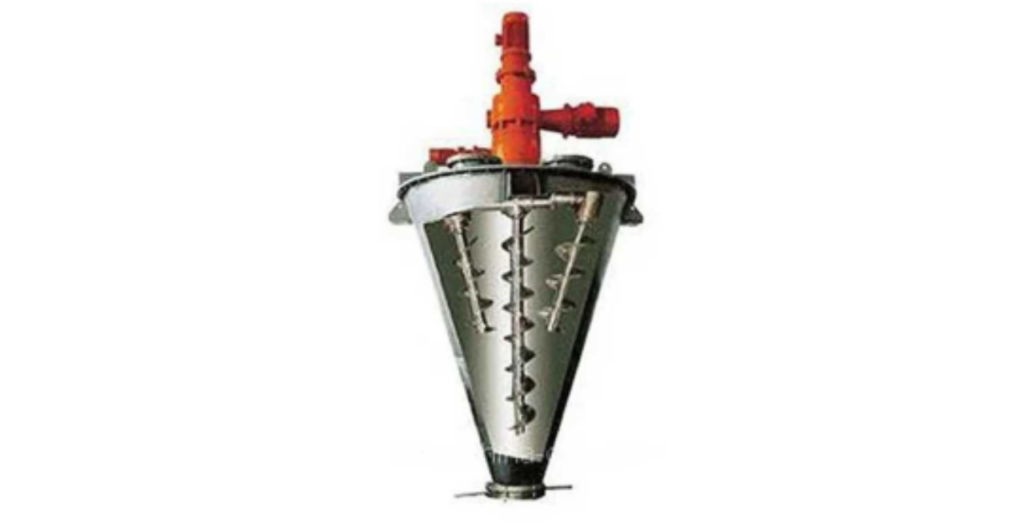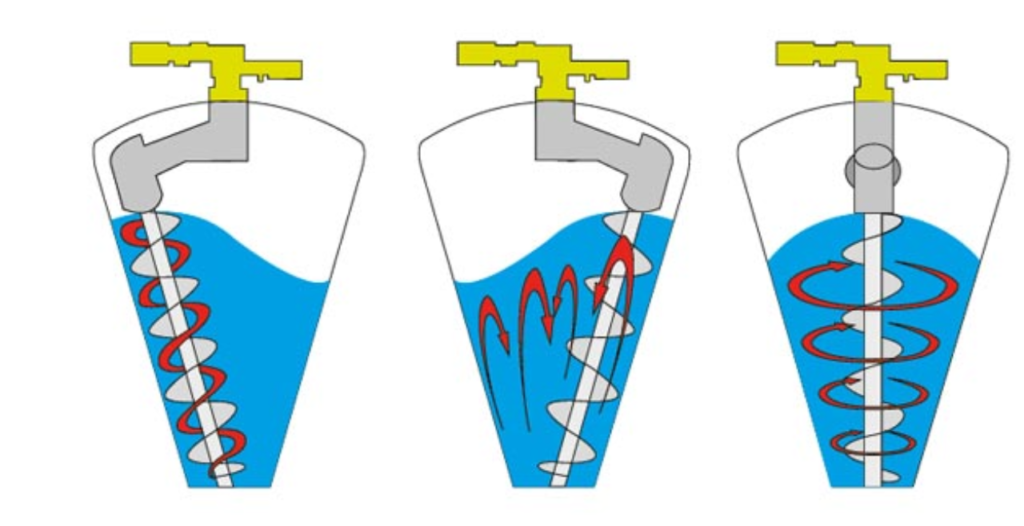Screw blenders, also known as screw mixers or ribbon screw blenders, are a type of mixing equipment used in blending technology to combine dry powders, granules, and other solid materials.
They are characterized by a helical screw or ribbon that rotates within a trough or cylinder, facilitating the mixing process. Here’s an overview of their working principles, advantages, and disadvantages:

Loading: The dry materials to be blended are loaded into the blender through an opening at the top or an inlet. | |
| Blending: The helical screw or ribbon inside the blender rotates, lifting the materials upward and then allowing them to cascade back down. This continuous lifting and cascading action creates a rolling or tumbling motion, which promotes the mixing of the materials. | |
| Mixing: As the materials tumble and fall, they mix with each other, resulting in thorough blending. The screw’s design and rotation speed can be adjusted to control the blending intensity and duration. | |
| Discharging: Once the blending process is complete, the blended mixture can be discharged through an outlet at the bottom of the blender. |

| Advantages of Screw Blenders: |
| Effective Mixing: Screw blenders provide efficient and uniform mixing, ensuring that all components are evenly distributed throughout the mixture. |
| Versatility: They can handle a wide range of materials, including powders, granules, and even materials with varying particle sizes. |
| Gentle Mixing: The mixing action of screw blenders is gentle on sensitive or fragile materials, reducing the risk of product degradation. |
| Customization: Screw blenders can be customized to meet specific blending requirements by adjusting factors like screw design, rotation speed, and mixing duration. |
| Ease of Cleaning: Many screw blenders are designed for easy cleaning and sanitation, making them suitable for industries with strict hygiene requirements. |

| Disadvantages of Screw Blenders: |
| Limited for Cohesive Materials: While screw blenders are effective for many materials, they may not be the best choice for cohesive or sticky materials, which can build up on the screw and hinder mixing. |
| Batch Process: They are typically used for batch processing, which may not be ideal for continuous production lines. |
| Complex Design: The presence of the screw or ribbon adds complexity to the blender’s design, which may require more maintenance over time. |
| Limited for High-Shear Mixing: Screw blenders may not be suitable for applications that require high-shear mixing or intense agitation. |
| Material Flow Issues: In some cases, certain materials may not flow well within the blender, leading to uneven mixing or material buildup. |

In summary, screw blenders are versatile and efficient mixing equipment that find applications in various industries, including pharmaceuticals, chemicals, food processing, and more.
Their ability to provide uniform mixing and their flexibility in customization make them valuable for blending dry solid materials. However, they may not be suitable for all materials, particularly those that are highly cohesive or require high-shear mixing.
The choice of blender type should be based on the specific characteristics of the materials and the blending requirements of the process.


 Sales & Marketing:
Sales & Marketing:  Service Supports:
Service Supports:  Website:
Website: 